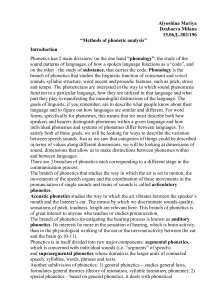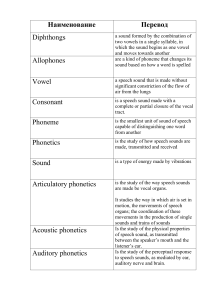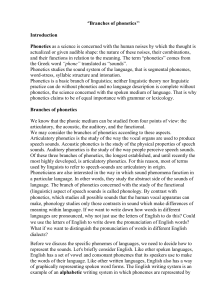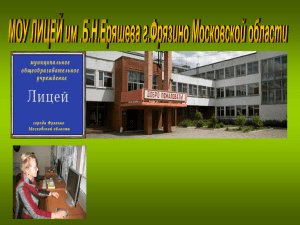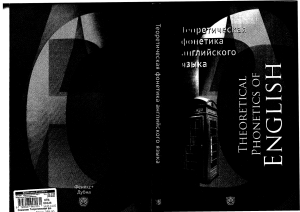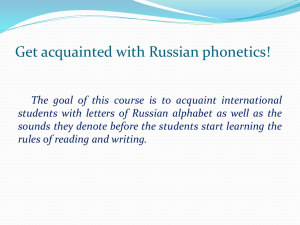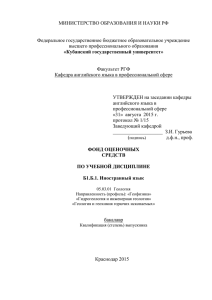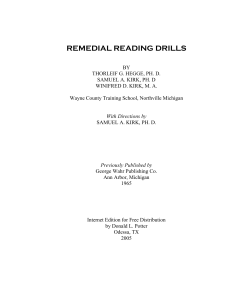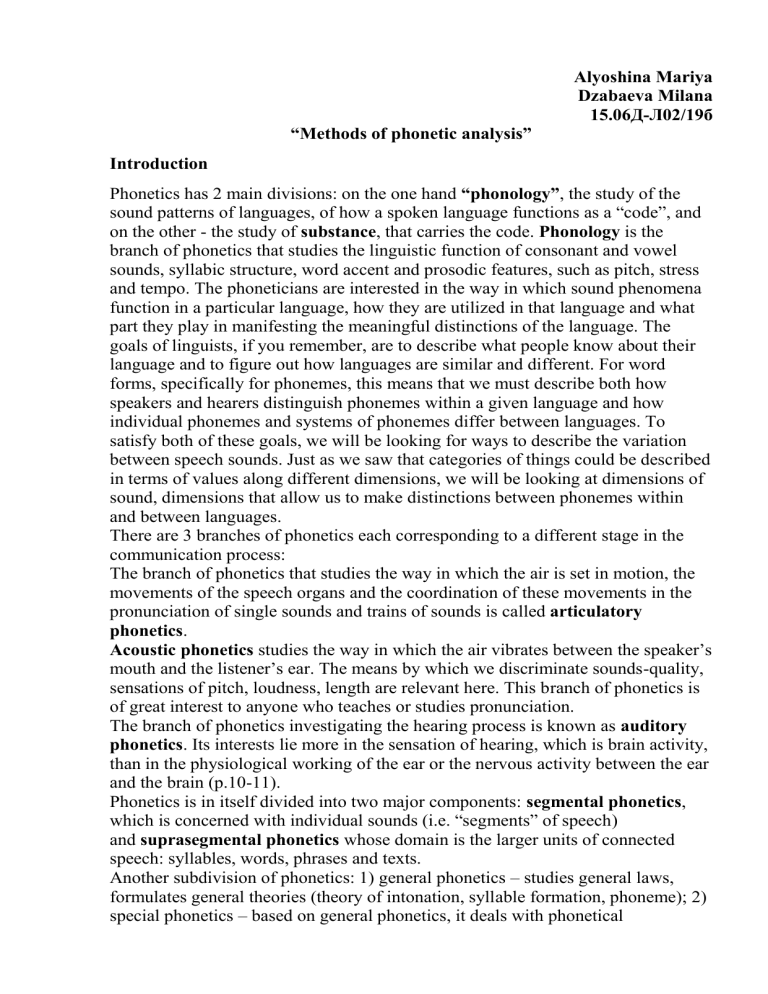
Alyoshina Mariya Dzabaeva Milana 15.06Д-Л02/19б “Methods of phonetic analysis” Introduction Phonetics has 2 main divisions: on the one hand “phonology”, the study of the sound patterns of languages, of how a spoken language functions as a “code”, and on the other - the study of substance, that carries the code. Phonology is the branch of phonetics that studies the linguistic function of consonant and vowel sounds, syllabic structure, word accent and prosodic features, such as pitch, stress and tempo. The phoneticians are interested in the way in which sound phenomena function in a particular language, how they are utilized in that language and what part they play in manifesting the meaningful distinctions of the language. The goals of linguists, if you remember, are to describe what people know about their language and to figure out how languages are similar and different. For word forms, specifically for phonemes, this means that we must describe both how speakers and hearers distinguish phonemes within a given language and how individual phonemes and systems of phonemes differ between languages. To satisfy both of these goals, we will be looking for ways to describe the variation between speech sounds. Just as we saw that categories of things could be described in terms of values along different dimensions, we will be looking at dimensions of sound, dimensions that allow us to make distinctions between phonemes within and between languages. There are 3 branches of phonetics each corresponding to a different stage in the communication process: The branch of phonetics that studies the way in which the air is set in motion, the movements of the speech organs and the coordination of these movements in the pronunciation of single sounds and trains of sounds is called articulatory phonetics. Acoustic phonetics studies the way in which the air vibrates between the speaker’s mouth and the listener’s ear. The means by which we discriminate sounds-quality, sensations of pitch, loudness, length are relevant here. This branch of phonetics is of great interest to anyone who teaches or studies pronunciation. The branch of phonetics investigating the hearing process is known as auditory phonetics. Its interests lie more in the sensation of hearing, which is brain activity, than in the physiological working of the ear or the nervous activity between the ear and the brain (p.10-11). Phonetics is in itself divided into two major components: segmental phonetics, which is concerned with individual sounds (i.e. “segments” of speech) and suprasegmental phonetics whose domain is the larger units of connected speech: syllables, words, phrases and texts. Another subdivision of phonetics: 1) general phonetics – studies general laws, formulates general theories (theory of intonation, syllable formation, phoneme); 2) special phonetics – based on general phonetics, it deals with phonetical peculiarities of a certain language; 3) some linguists distinguish historical phonetics – it traces the development of the phonetic system in the course of time finding out the basic laws of the system. Language is not an isolated phenomenon; it is a part of society and a part of ourselves. It is a prerequisite for the development of any society. No branch of linguistics can be studied without presupposing at least the study of other aspects of society. We see the development of quite distinct interdisciplinary subjects such as sociolinguistics (sociophonetics), psycholinguistics, mathematical linguistics and others. Sociophonetics studies the way in which pronunciation interacts with society. It is the study of the way in which phonetic structures change in response to different social functions and the deviations of what these functions are. Psycholinguistics as a distinct area of interest covers the psychological implications of an extremely broad area, from acoustic phonetics to language pathology (discusses the problem of acquisition of language by children, the extent to which language is influenced and influences such things as memory, attention, recall and constraints on perception, the extent to which language has a certain role to play in the understanding of human development, the problems of speech production). Acoustic phonetics comes close to studying physics and the tools used in this field enable the investigator to measure and analyze the movement of the air in terms of acoustics. A study of phonetics has educational value for almost everyone realizing the importance of language in human communication. The study of the complex of various communication techniques is definitely relevant to teaching a foreign language. As regards the learning of specific foreign languages, there has never been a time in the world when the ability of growing numbers of people to speak one another’s language really well has been of such significance as now. Knowledge of the structure of sound systems, and of the articulatory and acoustic properties of the production of speech is necessary in teaching foreign languages. The teacher has to know the starting point, which is the sound system of the pupil’s mother tongue as well as the aim of his teaching, which is a mastery of the pronunciation of the language to be learnt. He must be able to point out the difference between these two, and to arrange adequate training exercises. Ear training and articulatory training are both equally important in modern language teaching. The introductory of technical equipment – disks, taperecorders, language laboratories, etc – has brought about a revolution in teaching pronunciation of a foreign language. Because we will need a way to represent the phonemes of English and other languages unambiguously, we must rely on a set of symbols for this that are not used quite like the alphabets of any alphabetic writing systems. Symbols representing the basic sounds, or phones, of spoken languages, are called phonetic symbols. A study of phonetics has educational value for almost everyone realizing the importance of language in human communication. The study of the complex of various communication techniques is definitely relevant to teaching a foreign language. Methods of phonetic analysis. We distinguish between subjective, introspective methods of phonetic investigation and objective methods. The oldest, simplest and most readily available method is the method of direct observation. This method consists in observing the movements and positions of one's own or other people's organs of speech in pronouncing various speech sounds, as well as in analyzing one's own kinaesthetic sensations during the articulation of speech sound in comparing them with auditory impressions. Objective methods involve the use of various instrumental techniques (palatography, laryngoscopy, photography, cinematography, X-ray photography and cinematography and electromyography). This type of investigation together with direct observation is widely used in experimental phonetics. The objective methods and the subjective ones are complementary and not opposite to one another. Nowadays we may use the up-to-date complex set to fix the articulatory parameters of speech - so called articulograph. Acoustic phonetics comes close to studying physics and the tools used in this field enable the investigator to measure and analyze the movement of the air in the terms of acoustics. This generally means introducing a microphone into the speech chain, converting the air movement into corresponding electrical activity and analyzing (Ксень, это слово у Красы через «s», но, по-моему, тут «z») the result in terms of frequency of vibration and the amplitude of vibration in relation to time. The spectra of speech sounds are investigated by means of the apparatus called the sound spectrograph. Pitch as a component of intonation can be investigated by intonograph. The acoustic aspect of speech sounds is investigated not only with the help of sound-analyzing techniques, but also by means of speech-synthesizing devices. The aim of the phonological analysis is, firstly, to determine which differences of sounds are phonemic and which are non-phonemic and, secondly, to find the inventory of phonemes of the language. As it was mentioned above, phonology has its own methods of investigation. Semantic method is applied for phonological analysis of both unknown languages and languages already described. The method is based on a phonemic rule that phonemes can distinguish words and morphemes when opposed to one another. It consists in systematic substitution of one sound for another in order to find out in which cases where the phonetic context remains the same such replacing leads to a change of meaning. This procedure is called the commutation test. It consists in finding minimal pairs of words and their grammatical forms. For example: pen [pen] Ben [ben] gain [gain] cane [kain] ten [ten] den[den] Minimal pairs are useful for establishing the phonemes of the language. Thus, a phoneme can only perform its distinctive function if it is opposed to another phoneme in the same position. Such an opposition is called phonological. Let us consider the classification of phonological oppositions worked out by N.S. Trubetzkoy. It is based on the number of distinctive articulatory features underlying the opposition. 1. If the opposition is based on a single difference in the articulation of two speech sounds, it is a single phonological opposition, e.g. [p]-[t], as in [pen]-[ten]; bilabial vs. forelingual, all the other features are the same. 2. If the sounds in distinctive opposition have two differences in their articulation, the opposition is double one, or a sum of two single oppositions, e.g. [p]-[d], as in [pen]-[den], 1) bilabial vs. forelingual 2) voiceless-fortis vs. voiced-lenis 3. If there are three articulatory differences, the opposition is triple one, or a sum of three single oppositions, e.g. [p]- [ð], as in [pei]-[ ðei]: 1) bilabial vs. forelingual, 2) occlusive vs. constrictive, 3) voiceless-fortis vs. voiced-lenis. American descriptivists, whose most zealous representative is, perhaps, Zellig Harris, declare the distributional method to be the only scientific one. At the same time they declare the semantic method unscientific because they consider recourse to meaning external to linguistics. Descriptivists consider the phonemic analysis in terms of distribution. They consider it possible to discover the phonemes of a language by the rigid application of a distributional method. It means to group all the sounds pronounced by native speakers into phoneme according to the laws of phonemic and allophonic distribution: 1. Allophones of different phonemes occur in the same phonetic context. In this case their distribution is contrastive. 2. Allophones of the same phoneme(s) never occur in the same phonetic context. In this case their distribution is complementary. There is, however, a third possibility, namely, that the sounds both occur in a language but the speakers are inconsistent in the way they use them, for example, калоши-галоши, and [‘ei∫э - ‘егжэ]. In such cases we must take them as free variants of a single phoneme. We could explain the case on the basis of sociolinguistics. Thus, there are three types of distribution: contrastive, complementary and free variation.
